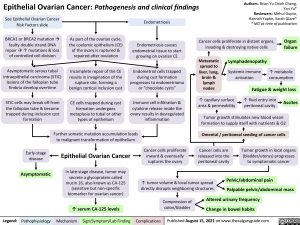Epithelial Ovarian Cancer: Pathogenesis and clinical findings
Authors: Brian Yu Chieh Cheng, Yan Yu* Reviewers: Mehul Gupta, Hannah Yaphe, Sarah Glaze* * MD at time of publication
See Epithelial Ovarian Cancer Risk Factors slide
BRCA1 or BRCA2 mutationà faulty double strand DNA
repairà↑ mutations & loss of controlled cell division
Asymptomatic serous tubal intraepithelial carcinoma (STIC)
lesions of the fallopian tube fimbria develop overtime
STIC cells may break off from the fallopian tube & become trapped during inclusion cyst formation
As part of the ovarian cycle, the coelomic epithelium (CE) of the ovary is ruptured & repaired after ovulation
Incomplete repair of the CE results in invagination of the
rupture site, forming a benign cortical inclusion cyst
CE cells trapped during cyst formation undergoes metaplasia to tubal or other types of epithelium
Endometriosis
Endometriosis causes endometrial tissue to start growing on ovarian CE
Endometrial cells trapped during cyst formation progresses to endometrioma or “chocolate cysts”
Immune cell infiltration & cytokine release inside the
ovary results in dysregulated inflammation
Cancer cells proliferate in distant organs, invading & destroying native cells
Organ failure
Metastatic spread to liver, lung, brain & lymph nodes
Lymphadenopathy
Systemic immune activation
↑ metabolic consumption
↑ capillary surface area & permeability
Fatigue & weight loss ↑ fluid entry into Ascites
peritoneal cavity
Further somatic mutation accumulation leads to malignant transformation of epithelium
Tumor growth stimulates new blood vessel formation to supply itself with nutrients & O2
Omental / peritoneal seeding of cancer cells
Early-stage disease
Asymptomatic
Epithelial Ovarian Cancer
In late-stage disease, tumor may secrete a glycoprotein called mucin 16, also known as CA-125 (sensitive but non-specific biomarker for ovarian cancer)
↑ serum CA-125 levels
Cancer cells proliferate inward & eventually ruptures the ovary
Cancer cells are released into the peritoneal cavity
Tumor growth in local organs (bladder/uterus) progresses to symptomatic cancer
↑ tumor volume & local tumor spread directly disrupts neighboring structures
Pelvic/abdominal pain
Palpable pelvic/abdominal mass Altered urinary frequency
Compression of
colon/bladder Change in bowel habits
Legend:
Pathophysiology
Mechanism
Sign/Symptom/Lab Finding
Complications
Published August 15, 2021 on www.thecalgaryguide.com
Foundations
Systems
Other Languages
Gynecology Pelvic Pain (Gynecologic Causes) Epithelial Ovarian Cancer: Pathogenesis and clinical findings epithelial-ovarian-cancer-pathogenesis-and-clinical-findings

